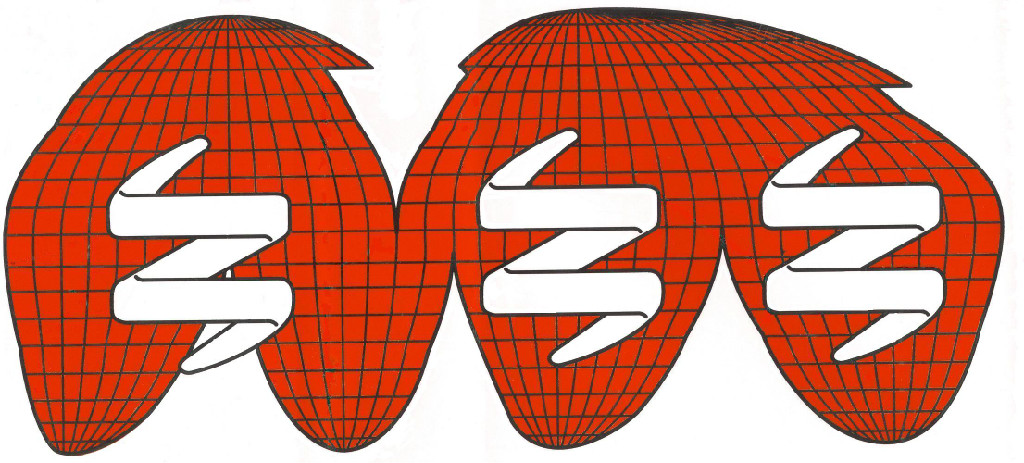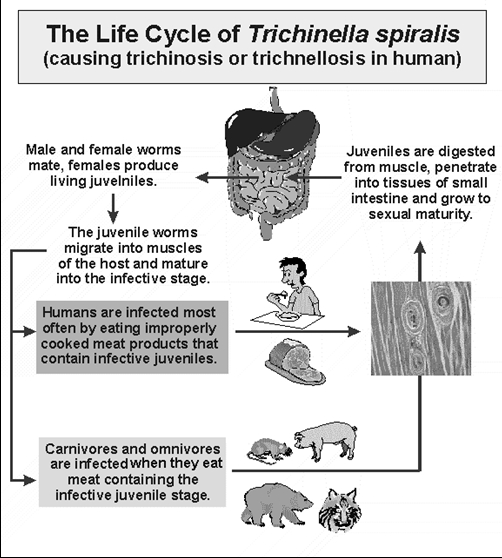Trichinella Life Cycle

International Commission on Trichinellosis
Trichinella Life Cycle
Trichinella spp. completes its entire life cycle in a single host (Figure 1).

The infective stage is the first stage (L1) larva which is found in striated muscle cells of a wide range of hosts. Upon ingestion of Trichinella-infected muscle tissue by a new host, larvae are released by the host digestive processes. Larvae then enter the small intestine and burrow into the lamina propria of the villi in the jejunum and ileum where they undergo four molts to the adult stage. Adult male and female worms mate and produce newborn larvae. Adult female worms in the small intestine continue to produce larvae in most hosts for several weeks before they are expelled. Each female worm bears approximately 1,500 newborn larvae, but this varies based on Trichinella species and host.
Newborn larvae leave the intestine and migrate, via the circulatory system, to striated muscle tissue. During migration, the larvae are known to enter many tissues, including those of the myocardium, brain, and other sites, but here they either are destroyed or re-enter the bloodstream. Generally, only larvae that reach striated muscles are able to continue development. They penetrate the sarcolemma of the fibers, where they mature. They become coiled within the fibers and, in the case of some of the species, are encapsulated as a result of the host's cellular response (Figure 2). This host-parasite complex, called the nurse cell, is capable of supporting the infective larvae for months or even years. An increased vascular supply to the nurse cell provides nutrients and oxygen vital to the parasite’s survival. The encapsulated cyst eventually becomes calcified and as a result the larva dies.
The time required for complete development takes from 17 to 21 days (time from exposure to appearance and encystment of larvae in musculature). Once adult worms are expelled and migrating larvae reach and encyst in muscle tissue, no further increase in number of worms can occur. An animal that is infected with Trichinella is at least partially refractory to a subsequent infection due to a strong and persistent immunity.
Further reading
Pozio, E. 2007. Taxonomy, biology and epidemiology of Trichinella parasites. In, (Dupouy-Camet, J and Murrell, K.D. eds.), FAO/WHO/OIE Guidelines for the Surveillance, Management, Prevention and Control of Trichinellosis, Rome, pp. 1-36.
The Trichinella Page - http://www.trichinella.org/bio_lifecycle.htm
Trichinella spp. completes its entire life cycle in a single host (Figure 1).

The infective stage is the first stage (L1) larva which is found in striated muscle cells of a wide range of hosts. Upon ingestion of Trichinella-infected muscle tissue by a new host, larvae are released by the host digestive processes. Larvae then enter the small intestine and burrow into the lamina propria of the villi in the jejunum and ileum where they undergo four molts to the adult stage. Adult male and female worms mate and produce newborn larvae. Adult female worms in the small intestine continue to produce larvae in most hosts for several weeks before they are expelled. Each female worm bears approximately 1,500 newborn larvae, but this varies based on Trichinella species and host.
Newborn larvae leave the intestine and migrate, via the circulatory system, to striated muscle tissue. During migration, the larvae are known to enter many tissues, including those of the myocardium, brain, and other sites, but here they either are destroyed or re-enter the bloodstream. Generally, only larvae that reach striated muscles are able to continue development. They penetrate the sarcolemma of the fibers, where they mature. They become coiled within the fibers and, in the case of some of the species, are encapsulated as a result of the host's cellular response (Figure 2). This host-parasite complex, called the nurse cell, is capable of supporting the infective larvae for months or even years. An increased vascular supply to the nurse cell provides nutrients and oxygen vital to the parasite’s survival. The encapsulated cyst eventually becomes calcified and as a result the larva dies.
The time required for complete development takes from 17 to 21 days (time from exposure to appearance and encystment of larvae in musculature). Once adult worms are expelled and migrating larvae reach and encyst in muscle tissue, no further increase in number of worms can occur. An animal that is infected with Trichinella is at least partially refractory to a subsequent infection due to a strong and persistent immunity.
Further reading
Pozio, E. 2007. Taxonomy, biology and epidemiology of Trichinella parasites. In, (Dupouy-Camet, J and Murrell, K.D. eds.), FAO/WHO/OIE Guidelines for the Surveillance, Management, Prevention and Control of Trichinellosis, Rome, pp. 1-36.
The Trichinella Page - http://www.trichinella.org/bio_lifecycle.htm
